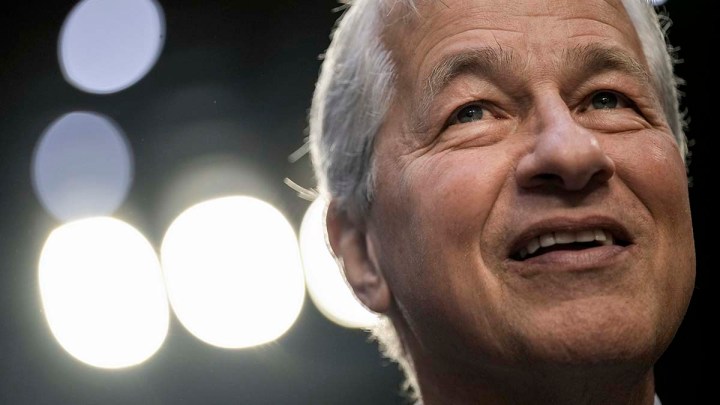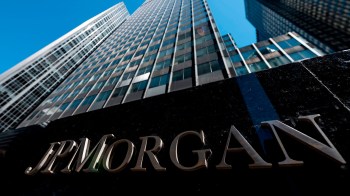
Why Jamie Dimon is the CEO that bridges Wall Street and Washington
Why Jamie Dimon is the CEO that bridges Wall Street and Washington

JPMorgan Chase is the biggest bank in the nation and getting bigger after taking over First Republic Bank following its seizure by federal regulators. In March, First Republic was teetering on the edge of failure; depositors had withdrawn billions of dollars after the failure of Silicon Valley Bank. Treasury Secretary Janet Yellen personally called Jamie Dimon, JPMorgan CEO, about a plan to extend First Republic a lifeline.
It’s been 100 years since a banker held so much sway over the economy, Emily Flitter wrote in the New York Times. She talked to Marketplace’s Kai Ryssdal about how Dimon is the last big bank CEO standing from the 2008 financial crisis and how “banks are now really intertwined in the stability of our global economy.”
The following is an edited transcript of their conversation
Kai Ryssdal: You point out in this piece that financial historians say that not since J.P. Morgan himself has a single businessman had such sway over this economy. Frame that for us historically, and then I want to talk about how it came to be.
Emily Flitter: So basically, it’s been 100 years plus since one guy had the power to step in and use his institution to calm things down. There are so many reasons why it’s been 100 years since then. And it’s not exactly the same. It’s not like Jamie Dimon has dictatorial control over the situation the way John Pierpont Morgan Sr. did, but there are some incredible similarities.
Ryssdal: It’s worth pointing out here that when First Republic first started to have problems after Silicon Valley Bank, and we were looking for sort of the next domino, Secretary of the Treasury Janet Yellen called Jamie Dimon personally. I think he was her first call.
Flitter: Right. I mean, think about it this way: You have these giant banks: You have Citigroup, you have Wells Fargo, you have Bank of America and you have JPMorgan. JPMorgan is the biggest. And look at Wells Fargo. They have had too many problems and they have done too many bad things recently to have authority. Citigroup too has had a lot of issues that they’re trying to deal with internally. Among other things, they accidentally sent $900 million to the wrong recipient just a few years ago, and JPMorgan has had, you know, some ups and downs, but nothing that makes them look wrong-footed or like they don’t have a handle on their operations, like the other banks. And that has begun to count for something.
Ryssdal: You pointed out in this piece — and I had kind of forgotten — that in 2008, Jamie Dimon had only been in that job at JPMorgan for two years. And now here he is kind of the last big bank CEO standing from that financial crisis. I wonder how much of his authority is just longevity?
Flitter: A lot of its longevity. But you know, it is hard to hang on to the bank CEO job these days. So his longevity counts for something. And you look at Bank of America, Brian Moynihan has been in there for a really long time. But he is post-crisis and Dimon is pre-crisis. Bank of America had to really pick itself back up, and JPMorgan didn’t. During the crisis, Dimon was very vocal in repeating that JPMorgan didn’t need help. And he was basically forced to take TARP [the Troubled Assets Relief Program], which was the bailout program that the government put together for all of the banks. Basically, he was forced to take it just to make the other banks look less bad. He never let anybody forget that. And he’s been capitalizing on that.
Ryssdal: So let me get you back to where we started: the idea that not since John Pierpont Morgan himself in 1907 has a single CEO of a company held this kind of sway over the American economy. Should we be concerned about that?
Flitter: We have seen an incredible increase in the power that big companies have. You know, I was also curious to know why no other bankers popped up as leaders the way Dimon has over the last 100 years. So I went back and looked, and from the 1930s to the 1990s, when we had the savings and loan crisis, we actually didn’t have bank runs. So we actually didn’t need to have a public adult in the room from Wall Street — that is part of it. But the other part is the banking industry has benefited from big changes in regulation. Starting in the 1990s, when a new law allowed banks to open branches in other states for the first time, you really saw the industry start to grow from that and consolidate. Then, the repeal of the Glass-Steagall Act, which was the big separation between investment banking and commercial banking — that created these absolute giants. These banks are now really intertwined in the stability of our global economy. It is a little scary.
There’s a lot happening in the world. Through it all, Marketplace is here for you.
You rely on Marketplace to break down the world’s events and tell you how it affects you in a fact-based, approachable way. We rely on your financial support to keep making that possible.
Your donation today powers the independent journalism that you rely on. For just $5/month, you can help sustain Marketplace so we can keep reporting on the things that matter to you.


















